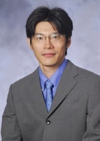Jun Ueda
Assistant Professor

- Office:
- Love 219
- Phone:
- 404-385-3900
- Email:
- jun [dot] ueda [at] me [dot] gatech [dot] edu
Biography
Dr. Ueda begins at Georgia Tech in May 2008 as Assistant Professor. Before Georgia Tech, he was a Visiting Scholar and Lecturer at MIT, where he worked on the development and control of cellular actuators inspired by biological muscle. He developed compliant, large strain piezoelectric actuators and a robust control method called stochastic broadcast feedback.
From 2002-2008 he was Assistant Professor at Nara Institute of Science and Technology in Japan, where he led a research group dedicated to dynamics and control in robotics, such as robot hand manipulation, tactile sensing, and power-assisting.
From 1996 to 2002 and prior to obtaining his Ph.D, he worked at the Advanced Technology R&D Center of Mitsubishi Electric Corporation in Japan. Here he was involved in a variety of activities including disk drives, machine tools, and satellite tracking antennas. His Ph.D. work at Kyoto University was on the end-point control of a robot manipulator mounted on a nonrigid base. He studied feedback control robustness in terms of the coupling of the arm and base dynamics.
Research
Robotics is an inherently interdisciplinary endeavor, requiring a deep understanding of classical subjects and broad knowledge of emerging scientific fields.
Dr. Ueda's interest is in the coordinated design of robotic components, such as mechanical and electrical. This coordinated design is the key for new robotics as well as for practical mechatronics in industry.
Dr. Ueda's research goal is to establish a theoretical design framework for highly integrated robotic systems. The application ranges from industrial robots, medical and rehabilitation robots, to intelligent assistive robots. Robustness against uncertainty of model and environment is crucial for these robots which work closely with humans or physically interact with humans and environments. The successful integration relies on the coordinated design of control, structure, actuators, and sensors by considering the dynamic interaction among them.
Actuators are a key component for new robotics. A cellular actuator concept inspired by biological muscle structure connects many small actuator units in series or in parallel, and composes in totality a single actuator. The method of stochastic broadcast control coordinates a vast number of units in this actuator system, which drastically improves wiring and addressing issues. Piezoelectric actuators using nested architecture with exponential strain amplification are developed for over twenty percent strain that is comparable to natural skeletal muscles.
